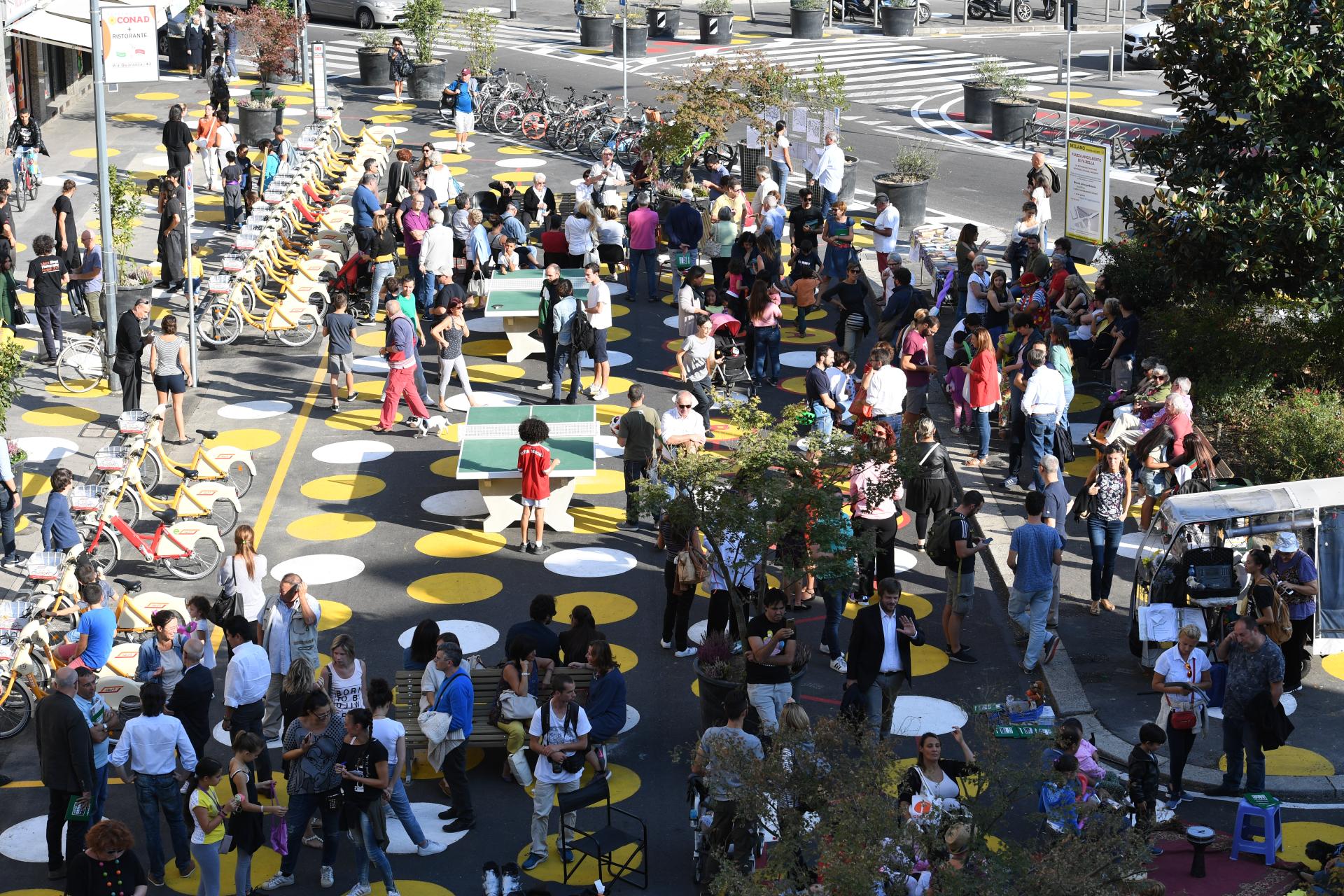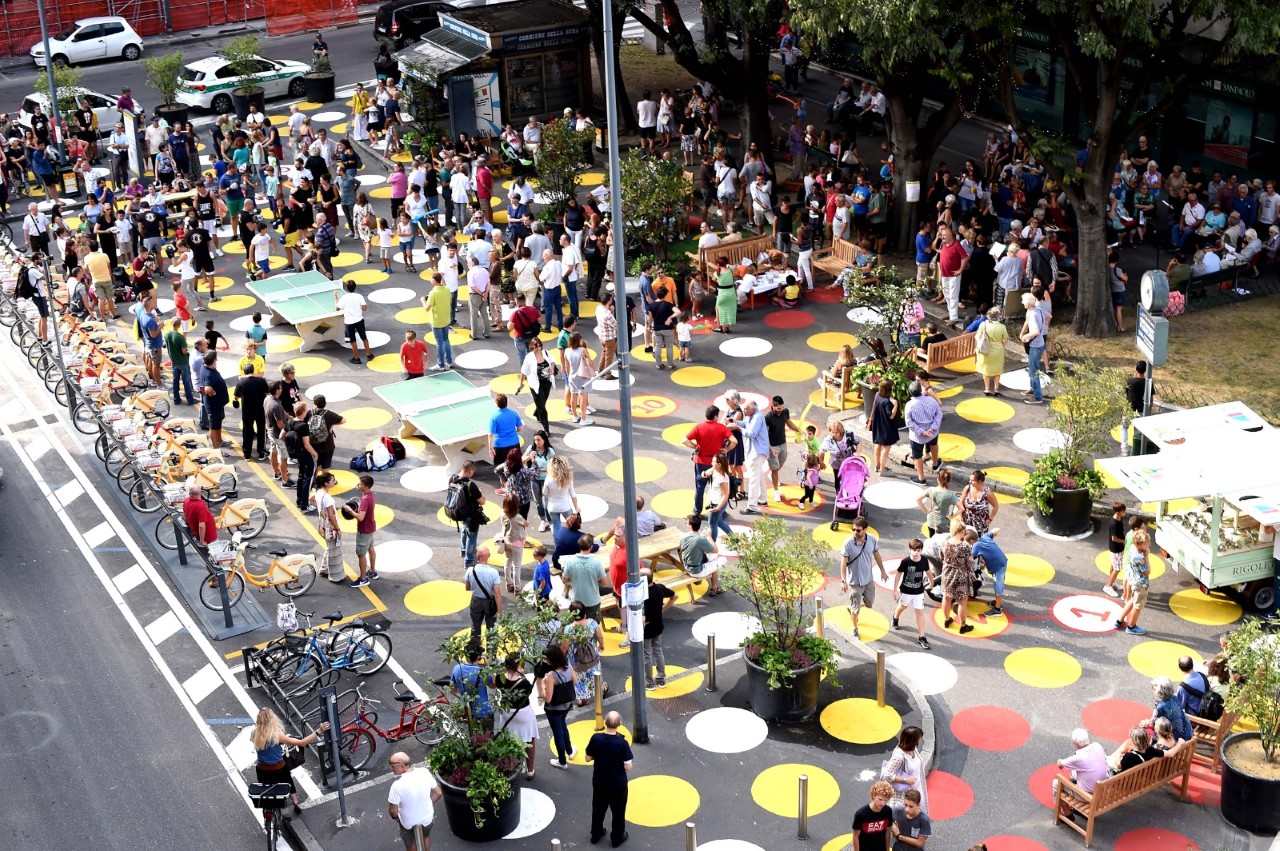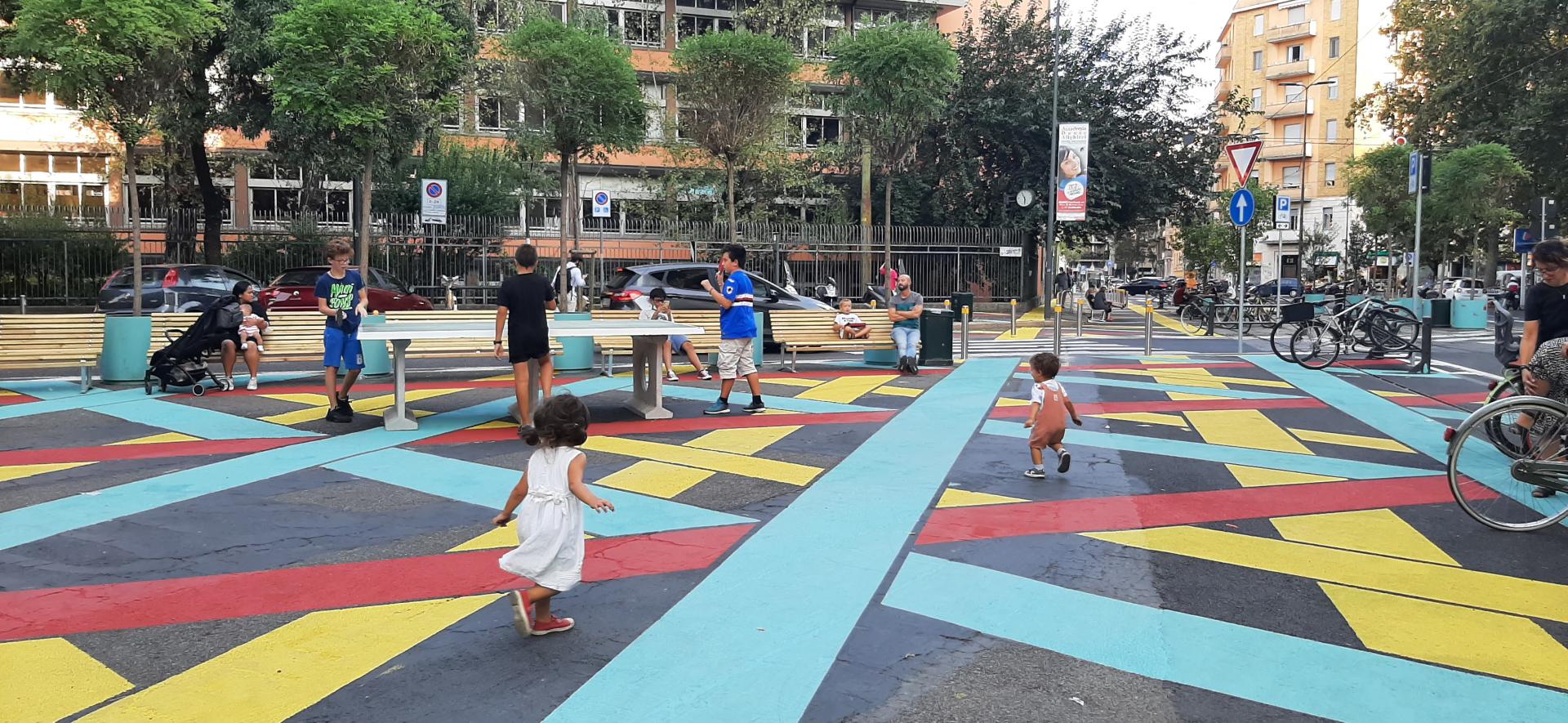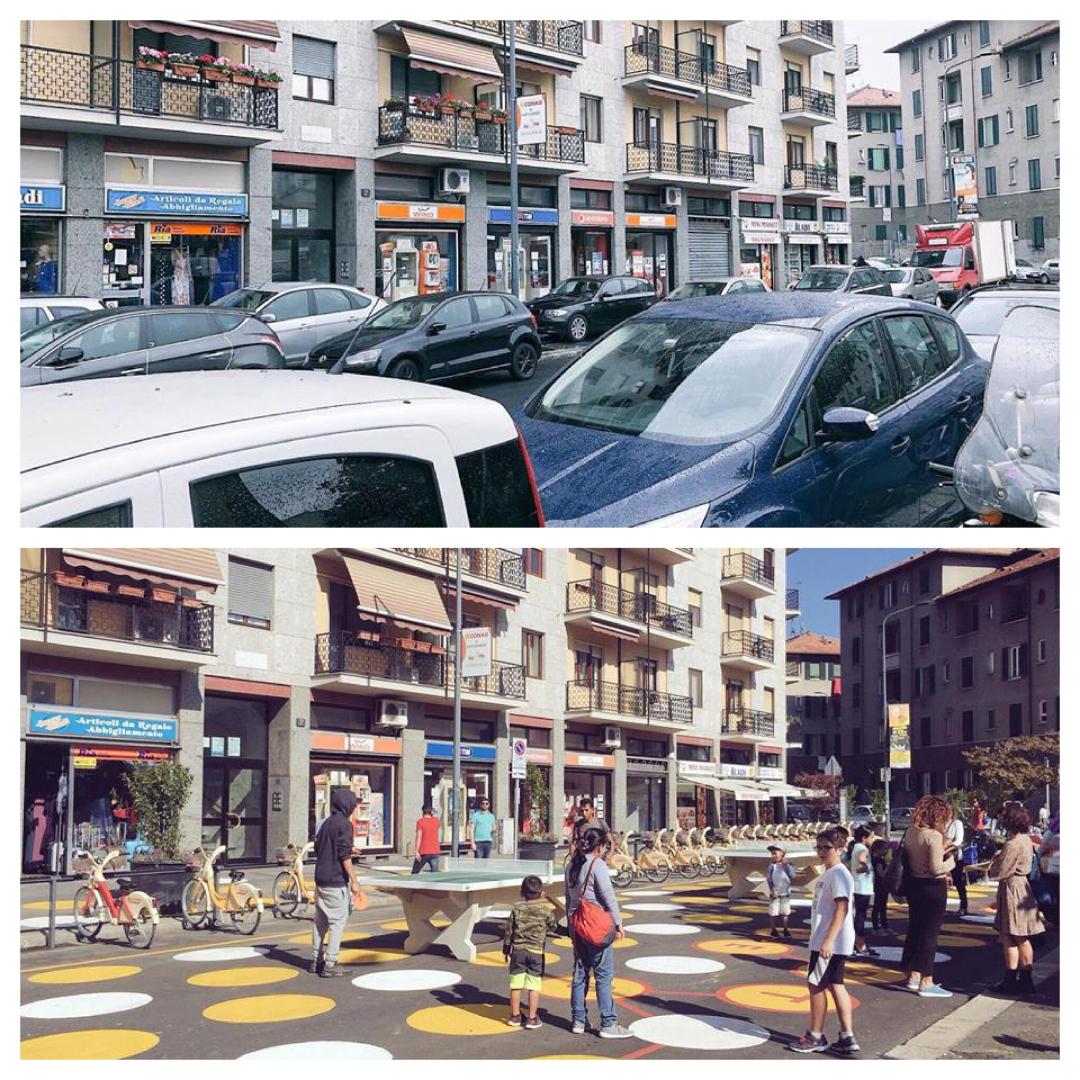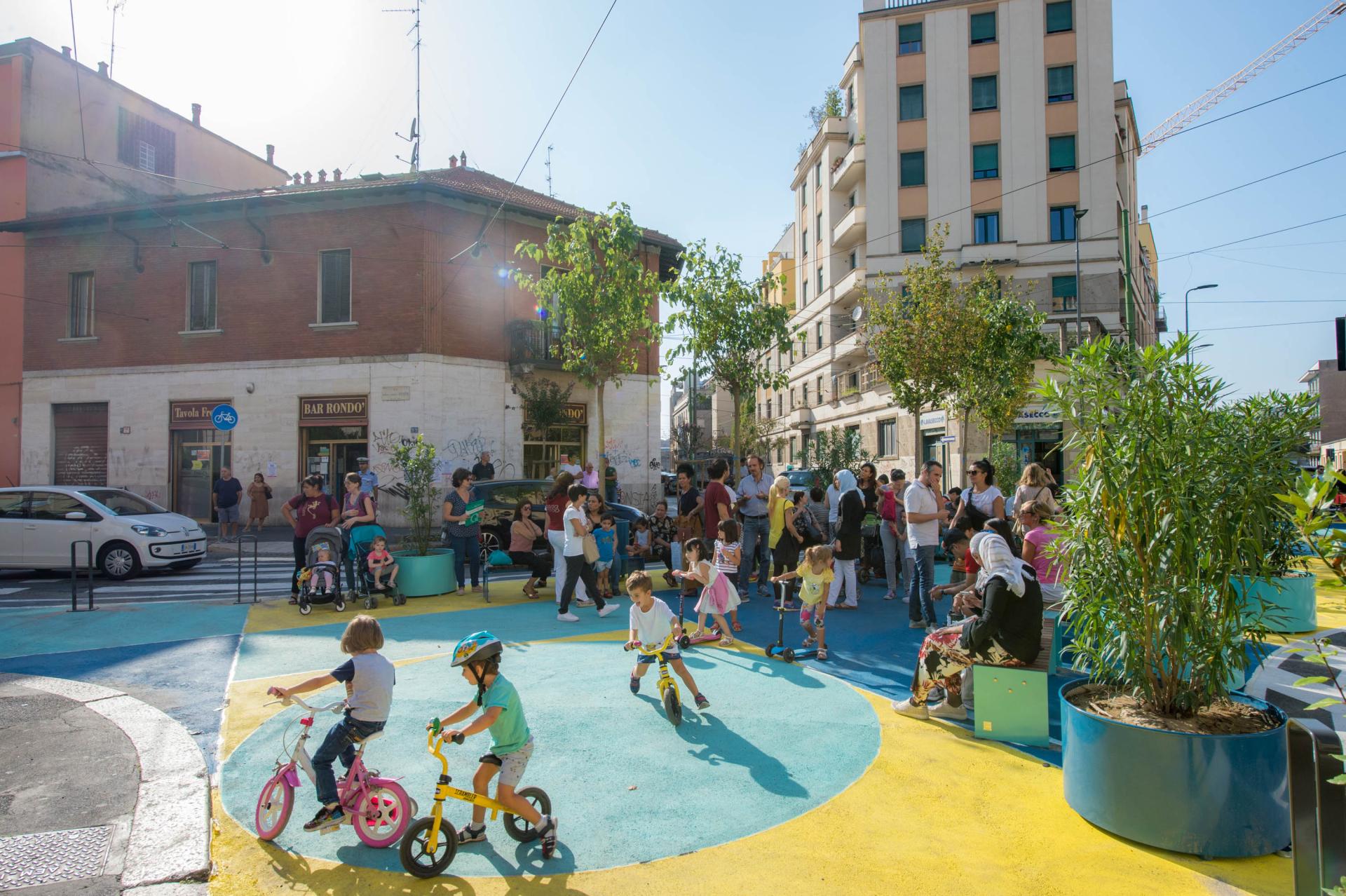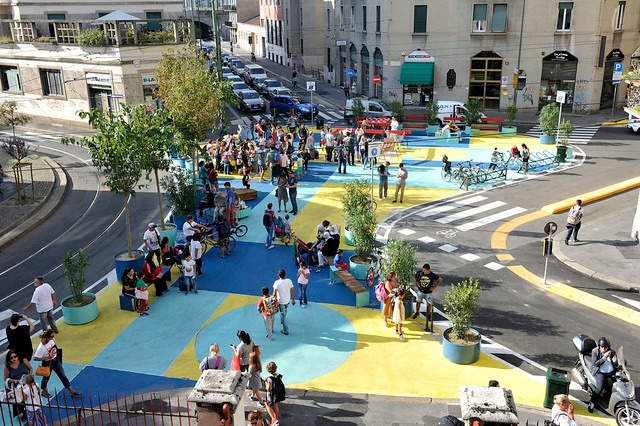Piazze Aperte (“Open Squares”)
Basic information
Project Title
Full project title
Category
Project Description
“Piazze Aperte” has aimed at shaping former streets and parking areas of the City of Milan into new public spaces, to be used for social relations and community-based activities. Thanks to this initiative, many reversible, unexpensive and co-designed experimental urban transformations have been activated, leading to many pedestrianization areas, pop-up bike lanes and to new places of social interaction, vitality, and gatherings, bringing urban spaces back into public life.
Geographical Scope
Project Region
Urban or rural issues
Physical or other transformations
EU Programme or fund
Which funds
Description of the project
Summary
Piazze Aperte is a program of the City of Milan, developed by Agenzia Mobilità Ambiente Territorio (AMAT), partnered up with Bloomberg Associates, the National Association of City Transportation Official (NACTO) and the Global Designing Cities Initiative. The program focuses on urban regeneration and sustainable mobility, key objectives of the Territory Governance Plan for Milan 2030 (PGT Milano 2030) and the Sustainable Urban Mobility Plan (PUMS).
Piazze Aperte aims at enhancing public spaces and turning them into community gathering places, it also aims at extending pedestrian areas, promoting sustainable mobility, and improving air quality and citizens’ well-being. This program uses the “tactical urbanism” approach to put public spaces once again at the center of community life and to encourage people to make the most of public squares. The temporary nature of the interventions makes it possible to act quickly and test solutions in a reversible manner, before investing time and resources in a permanent structural arrangement, supporting the decision-making process towards a permanent solution.
In addition, in 2019, the Municipality invited, with a public notice, all citizens to propose interventions on public spaces, aiming at involving the area’s inhabitants in the processes of urban regeneration. Thanks to this call, and through the signing of “collaborative agreements”, the City of Milan and its residents have been able to actively cooperate in the design, development, and implementation of public spaces, as well as promoted and preserved them, based on the principles of shared management. By giving people back their community spaces, the hope is that, through activities, gatherings, and even just simply “living” within these areas, public squares will once again regain their full status as local meeting places. To date, the Municipality of Milan has implemented more than 35 tactical interventions and continues to plan new ones.
Key objectives for sustainability
One of the key objectives of cities’ urban development plan is to tackle global warming, by reducing carbon emissions, limiting the increase of temperatures, and improving air quality. Piazze Aperte is deeply aligned with the above-mentioned objectives, considering that throughout its urban interventions has helped promoting more sustainable modes of transportation, through the increase of bike lanes and the reduction of cars and parking areas. It has used prefabricated materials, signs, and markings, to facilitate cycling in 30km/h zones, one- way streets, and areas as identified by the Sustainable Urban Mobility Plan (SUMP).
Piazze Aperte and its 22.000 mq2 of new pedestrian spaces, 310 potted plants, and 380 new bike tracks, acted towards sustainability in three steps:
- Short-term: instantly lowering local air pollution, PM10 and 2.5 values, resulting in an unquestionable advantage for the neighborhoods in terms of health.
- mid-terms: creating healthier, traffic-safer, and more pleasant environments, it has triggered positive habits in citizens’ habits, progressively more willing to move by foot and bikes throughout the city, lowering car usage.
- long-term: tactical urbanism interventions are progressively developed as permanent transformations where structural action of greening, microforestation and soil naturalization are possible, solving “urban heat islands” issues and lowering the necessity of air conditioning in buildings (also responsible of PM10 emissions).
For example, one of the very first interventions implemented, Piazza Angilberto, was pedestrianized, and paving has become more colorful, a new BikeMi station – a shared mobility station - has been installed and racks for private bicycles, some seats, as well as plants, flower boxes and ping pong tables have been laid. The carriageway has been narrowed and a new cycle path has been created.
Key objectives for aesthetics and quality
The results of this multi-layered experimentation are not only newly pedestrianized public spaces in strategic areas of the city, with the neighborhood life reactivated and fostering more sustainable lifestyles; they are also the production of pieces of original public art co-designed with the neighborhoods, mega illustrations at the urban scale of uncommon visual impact and aesthetic appeal, creating an essential precedent to the whole discipline of urban design in Italy. In 2020, the City of Milan issued a call for visual and relational artists and designers to mediate the participatory process in the pandemic year. By doing so, 43 proposals were collected from all Italy and abroad, beautiful site-specific graphic artworks. The winning proposal merged the artistic work of roman muralist and illustrator Camilla Falsini with the citizen engagement abilities by Jungle collective, resident in the neighborhood.The project includes different artworks but with the same aesthetic language. These include a small colorful area with a composition of shapes evoking an ideal two-dimensional city influenced by the tradition of the of classical Milanese design masters of the “Memphis” era and a graphic artwork containing a small maze with shapes for kids that can be interpreted as a playground for outdoor games. In addition, the inclusion of 32 ping-pong tables, asphalt art has led to a to a remarkable aesthetic effect in terms of street furniture, and has promoted children playgrounds creation and community gatherings within this new public space. In NoLo (North Loreto)district, the new Piazza Aperta consists of a multicolored pedestrian space in front of a primary school: the paving is colored in yellow, and blue, and flower boxes with racks, benches and ping pong tables have been added. The new space not only has more boundaries, but it also serves as improving the safety of pedestrians and cyclists, with a particular focus on children, elders and people with disabilities.
Key objectives for inclusion
Piazze Aperte wanted to shape public spaces, key areas for community spirit and social inclusion. In addition to high-quality urban design, this project wanted to achieve an “activation” of such spaces, through urban development and other efforts that respond to the needs of the people who experience them. Piazze Aperte has used a particular approach to develop affordable urban interventions within the city. In particular, the project used “tactical urbanism”, the innovative approach to urban design, based on short-term, low-cost measures aimed at creating new public spaces and safer streets. This type of intervention is well known and has been put into practice around the world for over a decade. From Barcelona, where the Superillas program helped to pedestrianize a significant proportion of the city, to New York, where Times Square has been pedestrianized. Interim, simple, fast and economical solutions can produce immediate benefits, test experimental solutions, help in making the right choices, and support future decision-making on permanent solutions. Tactical urbanism allows cities to try out new uses for urban spaces, and to launch long-term strategies to promote sustainable city living.
Moreover, Piazze Aperte’s key objectives have lied into developing co-designed urban transformations, to give all citizens the chance to live in better, colourful and safe public spaces. The project has specifically enhanced public participation and citizens’ engagement through an open call issued by the Municipality of Milan where everyone could submit ideas and suggestion on how to transform the city. The result was the collection of 60 proposals that saw the participation of about 800 residents, 200 not-for-profit organisations and 45 private entities. The advantages of this new approach are linked to the immediate impact that the projects have on residents, who can themselves become advocates for innovation and active participants in urban transformation.
Results in relation to category
The results achieved in terms of new pedestrian areas and furniture are as follows:
- 38 tactical urbanism interventions
- 250 benches
- 22.000 m2 of new pedestrian spaces
- 310 potted plants
- 380 new bike racks
- 35 tables
- 32 ping-pong tables
In addition, numbers can provide an eexhaustive overview about the impact of the project in terms of re-appropriation of sense of belonging and civic participation: 800 residents, 6 Business Improvement Districts, 9 neighborhood associations, 200 no-profit organizations and social cooperatives, 72 commercial businesses, 8 social streets, 17 schools, 10 public and private institutions, 45 private entities and 8 religious institutions took part in the Call for proposals.
The project led to an unprecedented bottom-up transformation of Milan into a place where the pedestrian experience becomes more and more attractive, while active mobility expands as the favorite means of transportation. Moreover, the intervention achieves the crucial impact of defending both bikers and pedestrians from accidents, enabling a more peaceful neighborhood life.
For example, one of the first interventions was Piazza Dergano, a small square in the center of the neighborhood, is named after. Here, the sidewalk on the north side has been “extended” to create a new, colorful, pedestrian space in the center of the square, available to residents for events and local festivities. Previously occupied by a parking lot, the space has been redesigned to accommodate seating, ping-pong tables, new plants, bike share and bike parking. The street network has been streamlined, with the narrowing of stretches of roadbed in order to reduce vehicle speeds and ensure the safe use of the new pedestrian area.
The intervention included:
- 620 m2 of new pedestrian areas:
- 12 benches
- 2 pic-nic tables
- 2 ping-pong tables
- 25 planters
- 3 bike racks
- BikeMi station point for sharing mobility
The square is now back to life, benefiting residents and businesses.
How Citizens benefit
Piazze Aperte has aimed to “activate” neighborhoods and develop activities and services for residents that involve regional networks and support citizens' organizations, paying particular attention to residents’ quality of life. The “Collaboration Agreement” have been written with residents and organizations, together with the Municipality, to define the aims, objectives and expected results of the “Piazze Aperte” program, as well as the organization of maintenance, shared management, and regeneration of communal spaces. Through collaboration agreements, pursuant to the “Common Goods Regulations” – a Municipal regulation governing the participation of active citizens in care, management and regeneration of urban commons- active citizens, informal groups, associations, educational institutions, committees, foundations, and companies promoting "corporate maintenance" can collaborate with the Administration to implement programs that address the management, maintenance, improvement, and activation of various forms of urban commons.
Locals have been asked then to be involved and have a say within the process to regenerate public squares. The project believed crucial to communicate, involve and engage locals, businesses, and associations in the re-definition of space, once used to park, but meant to foster social relations and community-based activity to shape the usage and management of the city as a whole.
In addition to this, in 2019 the Municipality of Milan launched an open call to gather proposals for new Piazze Aperte projects: as previously mentioned, more than 60 proposals were collected and most of them were completed throughout 2020 and 2021.
Physical or other transformations
Innovative character
The usage of “tactical urbanism”, which comprehends low-cost and effective urban interventions to promote social relations and increase the number of public squares to be used for and by citizens, has an extremely innovative approach, considering that it is not formally included within consultation process found in architecture and formal placemaking activities.
Tactical urbanism measures allow cities to try out new uses for urban spaces, and to launch long-term strategies to promote city living. The advantages of this new approach are linked to the immediate impact that these measures have on residents, who can themselves become advocates for innovation projects and active participants in urban transformation.
These kinds of projects are more citizen-based, often taking a critical stance on spaces that the community believes are underused or not being used properly, giving bottom-up and local solutions. Furthermore, tactical urbanism is a guerrilla approach to urban design that empowers communities without getting caught in the slow process of land-use legalities or policymaking.
Learning transferred to other parties
For years, the Municipality of Milan has been committed to the dissemination and sharing of knowledge as a leader in urban regeneration and sustainable mobility through participation and membership in networks which allow to exploit knowledge, experiences and promote the replicability of successful innovative solution.
This urban transformation process is inherently scalable and replicable to different contexts. Tactical urbanism has already a full decade of implementation history all over the world, with uncountable declinations throughout any sort of social and spatial global contingence. The specific experience of “Piazze Aperte in Ogni Quartiere” (“Open Squares in every Neighborhood”), by its side, unique with its super-inclusive participatory process, surely needs a strong political will of openness and sharing towards the stakeholders to be replicated, and the collaboration of all levels of the administrative local action; but with this pre-condition, it is transferrable. Being also an output of “CLEAR - City Liveability by Redesign” (funded by EIT Urban Mobility in 2020), this implementation comes from an expertise exchange where Milan worked together with Munich and Amsterdam as well as their Technical Universities and further private actors with the aim to expand the field of known tactical urbanism techniques. The consortium is in the process of building a growing repository of good practices (https://www.streetexperiments.com/), with the exact aim of making each of them easily compared, composed and transferred to other sites and contexts for a collective global learning.

